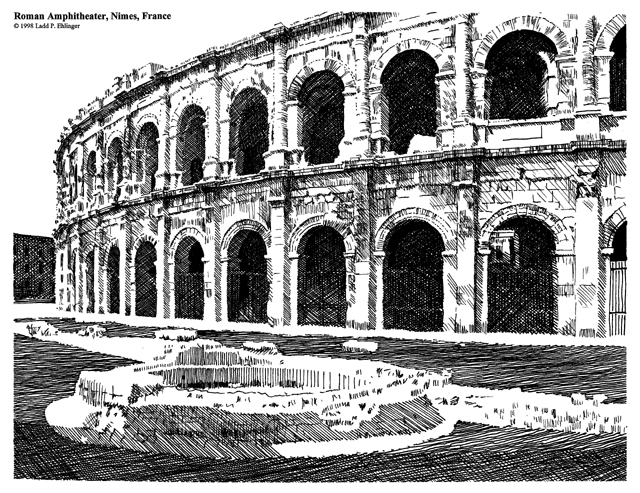
Projects Newsletters Personnel Contact

Arena is a Latin word that means sand or beach, and was applied as a name to amphitheaters in Roman times because so much sand was used to soak up the blood of the amphitheater’s combatants. The prefix amphi means all around, and when added to theater, connoted what was in reality two combined theaters.
Amphitheaters were used as assembly structures for the entertainment of the Roman populace with gladiatorial hand to hand combat (ostensibly for the training of warriors), man and beast combat (for rather sadistic entertainment), and in some instances they were used for naval combat exhibitions. Water pipes for flooding the central arena still exist.
This issue’s limited edition signed print by Ladd Ehlinger is of the arena of Nîmes in southern France. This amphitheater is the best preserved of all the 60 surviving Roman amphitheaters, the most famous of which are: Rome (the Colosseum), Arles (very near Nîmes), Verona, Pompeii, and El- Djem (Thysdrus). It was built in the reign of Augustus a few years BC to seat 21,000 spectators, the seats for which are all remarkably preserved. The slaves sat at the top, the ordinary folk in the middle seats and the upper classes at the bottom - the more upper, the more one was in the shade.
The barrel vaults, groin vaults, and other stonework of this structure including the topmost consoles with holes for the awning poles are all there. The exterior design expresses the vaulting of the elliptical plan (133M x 101M) with round arched arcades that are rhythmically articulated by pilasters between, square on the lower level and semicircular on the upper level, and cornices at the level’s line.
Nîmes is an area that contains many famous Roman ruins: the Pont du Gard (a sketch in a previous newsletter), the Maison Carrée, Diana’s Temple, the Castellum, and the Augustus Gate. Also, there are many Roman ruins at nearby Arles. The Pont du Gard was the aqueduct / bridge source of the water that was used in the naval exhibitions. The Roman Latin name for Nîmes was Nemausus after the spirit of a local spring. It was founded by Augustus to reward his Legionnaires with land grants for their victory over his rival Marc Antony. Nîmes is in the present day region of Provence, and lies between the limestone hills of the Garrigue to the north and the alluvial plain of the Costière du Gard to the south.
Over the years, the amphitheater suffered: the Visigoths turned it into a fortress by blocking the arched openings with walls, building towers, and surrounding it with a moat. The Knights of the Arena held it for a while during the time of the Crusades, and at the end of the middle ages it became a village, occupied by some 2,000 people who built houses and a chapel within the ellipse itself by utilizing the stones of the amphitheater. When the 19th century rehabilitation began, a 25' deep layer of rubble had to be first removed.